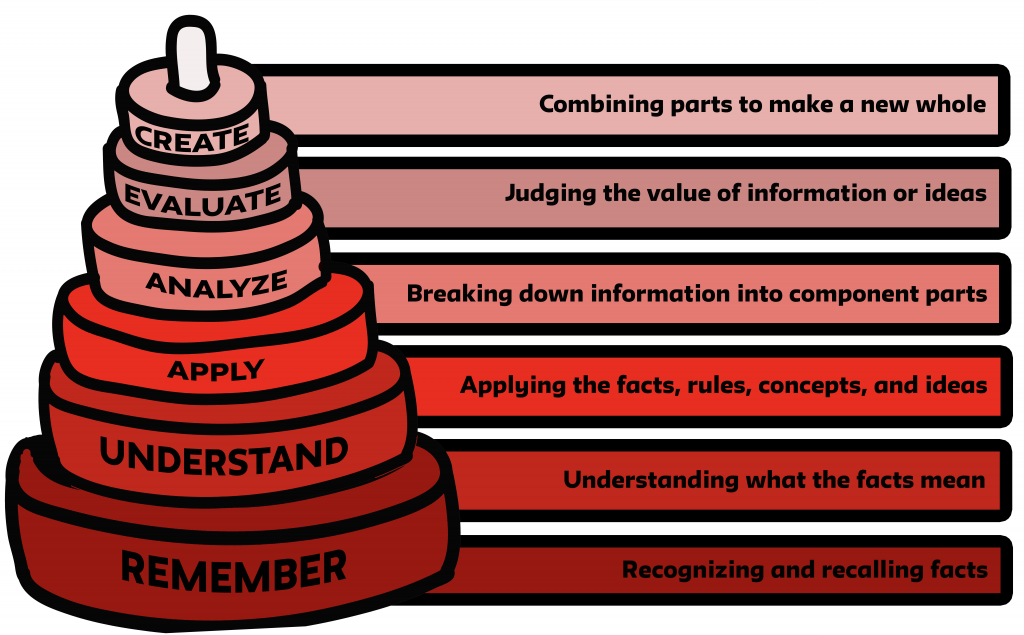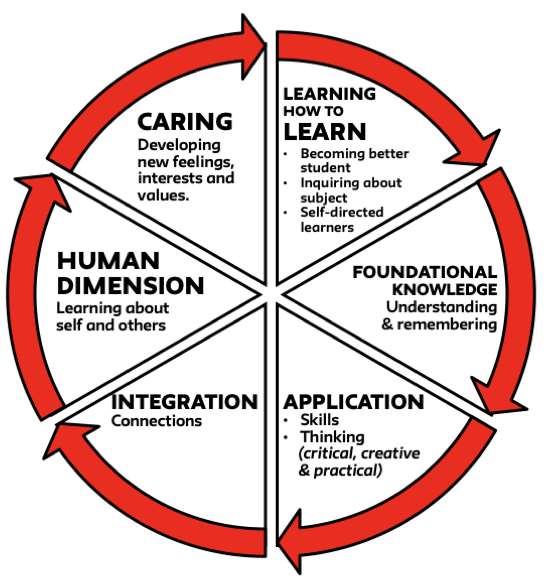Learning Taxonomies
Bloom’s
Many faculty are at least somewhat familiar with Bloom’s Taxonomy. Bloom’s taxonomies, created in 1956 under the supervision of the educational psychologist Benjamin Bloom, are helpful classifications for designing levels of student learning experiences. The cognitive framework, most commonly used and the one usually meant when we refer to ‘Bloom’s Taxonomy’, includes the categories in the graphic on the left. The argument presented through this hierarchy is that learning is a process of working through the levels in order to achieve higher order thinking. While we all want our students to be engaged with analysis, synthesis, evaluation and most importantly innovation, to get there we need to work through the lower order processes of acquiring knowledge through remembering, understanding and application. Less commonly used, but highly relevant, is the affective framework, which involves the manner in which we deal with things emotionally, such as feelings, values, appreciation, enthusiasms, motivations and attitudes. The final domain is the psychomotor, including physical movement, coordination, and use of motor-skill areas and of particular relevance to any learning that requires physicality. Some faculty teach students about Bloom’s taxonomies as part of their metacognitive teaching practices.
We include all three of Bloom’s learning domains as it’s important for faculty to remember that students aren’t just learning with their minds, they’re learning with their bodies and their emotions and their minds, bodies and emotions affect how they learn.
Cognitive Domain

The illustration here is revised from the original and while it appears to represent a hierarchy and that’s the way Bloom’s group originally thought of it in the intervening years, people have experimented with non-hierarchical representations.
One value of showing Bloom’s cognitive domain to students is that the foundation is ‘remembering’. With students’ ready access to information, many don’t think they need to remember things because they can just google it. But it’s important to embed knowledge in your mind for easier retrieval and for making connections across different subjects, processes and domains.
Affective Domain

The affective domain includes the manner in which we deal with things emotionally, such as feelings, values, appreciation, motivations and attitudes and asks you to create opportunities for students to develop awareness, attention, understanding of cultural differences, ethical standards, self reliance and cooperation. Tends to be neglected, but particularly now, thinking about students’ emotions in the context of your course content sets stage for more open interaction.
Psychomotor Domain

The psychomotor domain includes physical movement, coordination, and use of the motor-skill areas. Development of these skills requires practice and is measured in terms of speed, precision, distance, procedures, or techniques in execution. They range from rudimentary manual tasks, such as digging a ditch to complex psychomotor skills used in drawing and painting, making a hat, dancing and playing the violin.
Dee Fink’s
Fink’s taxonomy of significant learning is holistic and iterative. In this taxonomy, learning feeds learning.
Consider teaching students Bloom’s cognitive domain early in the semester and then, a little later, introducing the Taxonomy of Significant Learning illustrated here.
